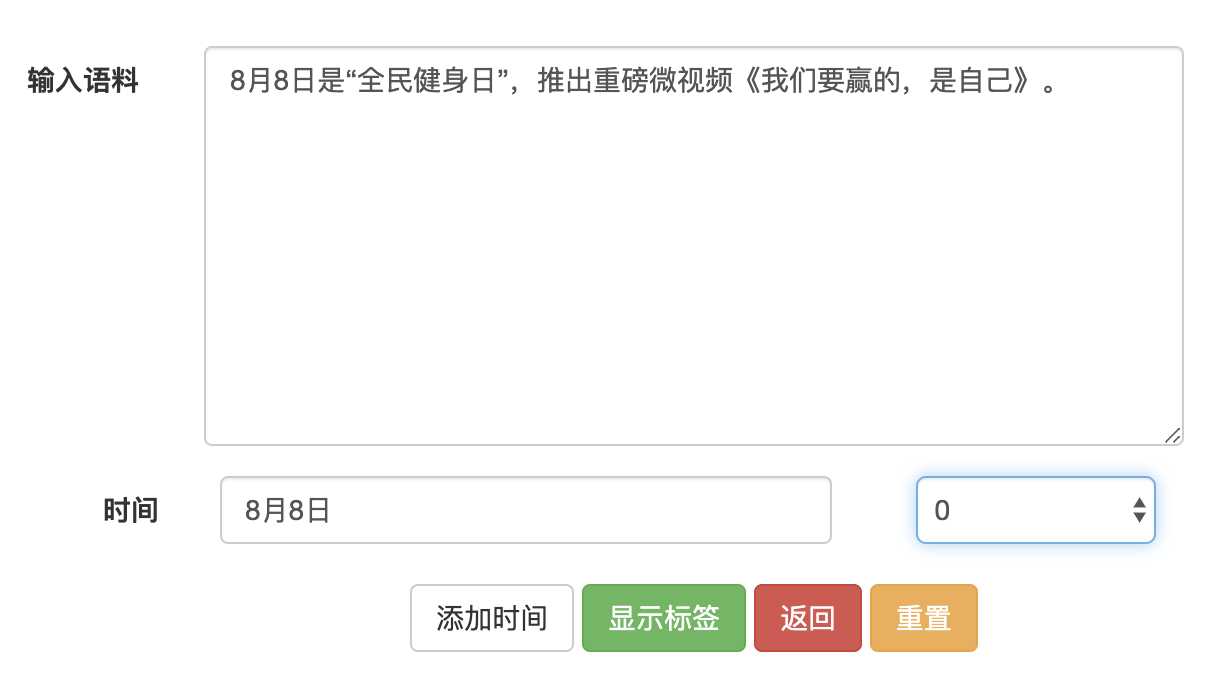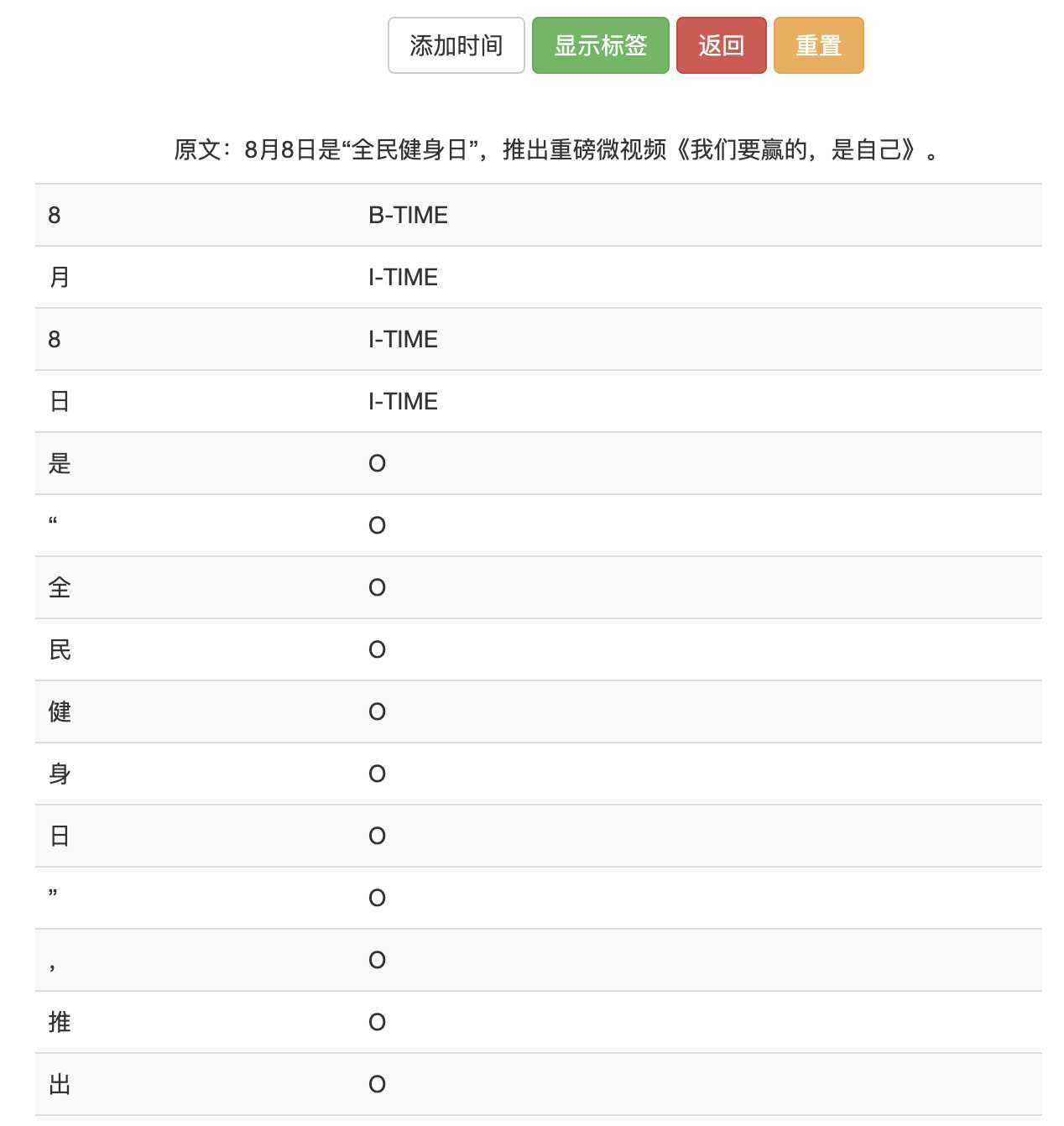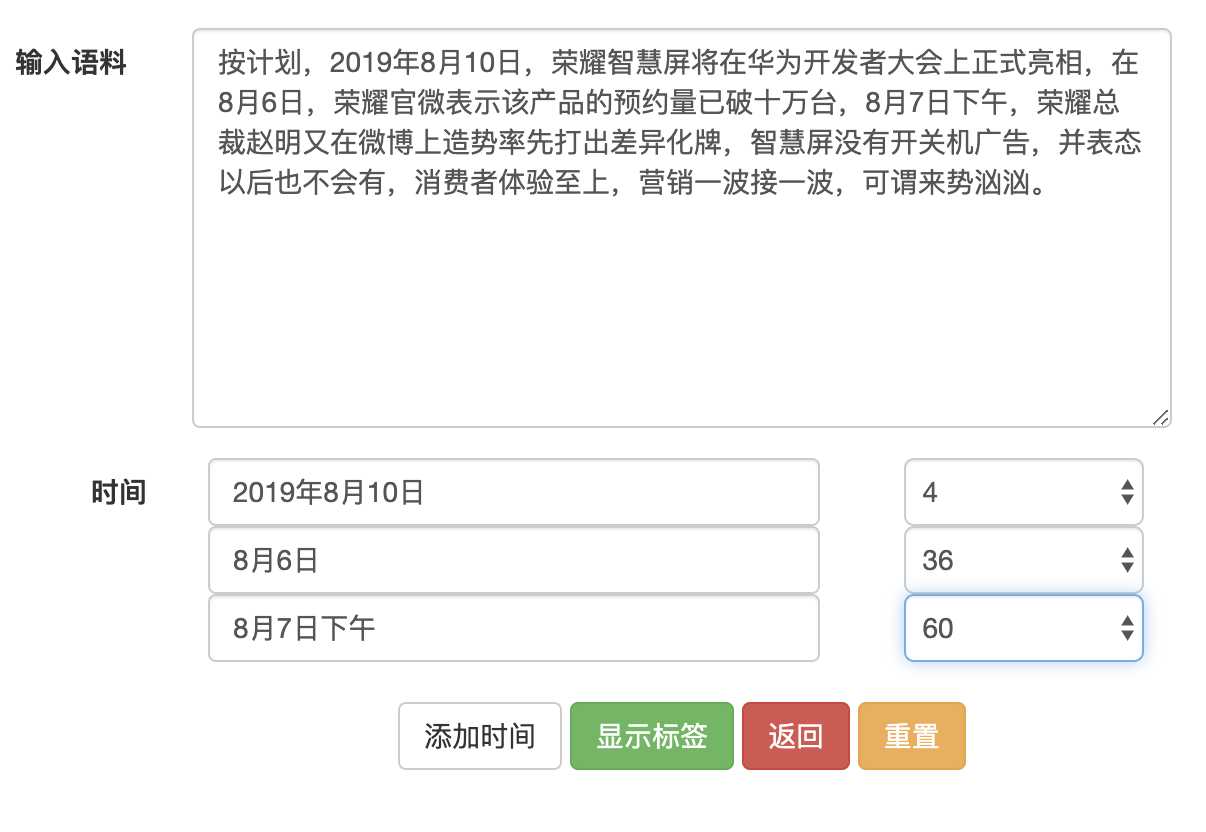NLP(十四)自制序列标注平台
Posted jclian91
tags:
篇首语:本文由小常识网(cha138.com)小编为大家整理,主要介绍了NLP(十四)自制序列标注平台相关的知识,希望对你有一定的参考价值。
背景介绍
??在平时的NLP任务中,我们经常用到命名实体识别(NER),常用的识别实体类型为人名、地名、组织机构名,但是我们往往也会有识别其它实体的需求,比如时间、品牌名等。在利用算法做实体识别的时候,我们一般采用序列标注算法,这就对标注的文本格式有一定的要求,因此,一个好的序列标注的平台必不可少,将会大大减少我们标注的工作量,有效提升算法的更新迭代速度。
??本文将介绍笔者的一个工作:自制的序列标注平台。我们以时间识别为例。比如,在下面的文章中:
按计划,2019年8月10日,荣耀智慧屏将在华为开发者大会上正式亮相,在8月6日,荣耀官微表示该产品的预约量已破十万台,8月7日下午,荣耀总裁赵明又在微博上造势率先打出差异化牌,智慧屏没有开关机广告,并表态以后也不会有,消费者体验至上,营销一波接一波,可谓来势汹汹。
我们需要从该文章中标注出三个时间:2019年8月10日,8月6日,8月7日下午,并形成标注序列。
??下面将详细介绍笔者的工作。
序列标注平台
??由于开发时间仓促以及笔者能力有限,因此,序列标注平台的功能还没有很完善,希望笔者的工作能抛砖引玉。
??项目的结构图如下:

templates中存放静态资源,time_index.html为平台的操作界面,time_output为平台标注完实体后的文件保存路径,time_server.py是用tornado写的服务端路径控制代码,utils.py中是获取某个路径下的txt文件的最大数值的函数。
??其中,utils.py的完整代码如下:
# -*- coding: utf-8 -*-
# time: 2019-03-14
# place: Xinbeiqiao, Beijing
import os
# 获取当前所在目录的txt文本的最大数值
def get_max_num(path):
files = os.listdir(path)
if files:
numbers = list(map(lambda x: int(x.replace('.txt', '')), files))
return max(numbers)
else:
return 0??time_server.py的完整代码如下:
# -*- coding: utf-8 -*-
# time: 2019-08-08
# place: Xinbeiqiao, Beijing
import os.path
import tornado.httpserver
import tornado.ioloop
import tornado.options
import tornado.web
from tornado.options import define, options
from utils import get_max_num
#定义端口为9005
define("port", default=9005, help="run on the given port", type=int)
# GET请求
class QueryHandler(tornado.web.RequestHandler):
# get函数
def get(self):
self.render('time_index.html', data = ['', []])
# POST请求
class PostHandler(tornado.web.RequestHandler):
# post函数
def post(self):
# 获取前端参数, event, time, index
event = self.get_argument('event')
times = self.get_arguments('time')
indices = self.get_arguments('index')
print(event)
print(times)
print(indices)
# 前端显示序列标注信息
tags = ['O'] * len(event)
for time, index in zip(times, indices):
index = int(index)
tags[index] = 'B-TIME'
for i in range(1, len(time)):
tags[index+i] = 'I-TIME'
data = [event, tags]
self.render('time_index.html', data=data)
# 保存为txt文件
dir_path = './time_output'
with open('./%s/%s.txt' % (dir_path, get_max_num(dir_path)+1), 'w', encoding='utf-8') as f:
for char, tag in zip(event, tags):
f.write(char+'\\t'+tag+'\\n')
# 主函数
def main():
# 开启tornado服务
tornado.options.parse_command_line()
# 定义app
app = tornado.web.Application(
handlers=[(r'/query', QueryHandler),
(r'/result', PostHandler)
], #网页路径控制
template_path=os.path.join(os.path.dirname(__file__), "templates") # 模板路径
)
http_server = tornado.httpserver.HTTPServer(app)
http_server.listen(options.port)
tornado.ioloop.IOLoop.instance().start()
main()??time_index.html文件如下:
<!DOCTYPE html>
<html>
<head>
<meta charset="utf-8">
<title>时间抽取标注平台</title>
<link rel="stylesheet" href="https://cdn.staticfile.org/twitter-bootstrap/3.3.7/css/bootstrap.min.css">
<style>
mark
background-color:#00ff90; font-weight:bold;
ptext-indent:2em;
</style>
</head>
<body>
<center>
<br><br><br>
<form class="form-horizontal" role="form" method="post" action="/result" style="width:600px">
<div class="form-group">
<label for="event" class="col-sm-2 control-label">输入语料</label>
<div class="col-sm-10">
<textarea type="text" class="form-control" id="event" style="width:490px; height:200px" name="event"></textarea>
</div>
</div>
<div class="form-inline" style="text-align:left;">
<label for="time_0" class="col-sm-2 control-label">时间</label>
<div class="col-sm-10" id="time_column">
<input type="text" class="form-control" id="time_0" style="width:306px;" name="time" />
   
<select class="form-control" id="index_0" name="index" style="width:120px;" ondblclick="select_click(0)"></select>
</div>
</div>
<div class="form-group">
<div class="col-sm-offset-2 col-sm-10">
<br>
<button type="button" class="btn btn-default" id="add_time">添加时间</button>
<button type="submit" class="btn btn-success">显示标签</button>
<a href="/query"><button type="button" class="btn btn-danger">返回</button></a>
<button type="reset" class="btn btn-warning">重置</button>
</div>
</div>
</form>
<br>
<div style="width:600px">
<p> 原文:data[0] </p>
<table class="table table-striped">
% for char, tag in zip(data[0], data[1]) %
<tr>
<td>char </td>
<td>tag </td>
</tr>
%end%
</table>
</div>
</center>
</body>
</html>平台使用
??运行上述time_server.py后,在浏览器端输入网址: http://localhost:9005/query , 则会显示如下界面:

??在输入语料框中,我们输入语料:
8月8日是“全民健身日”,推出重磅微视频《我们要赢的,是自己》。
在时间这个输入框中,可以标注语料中的时间,同时双击同一行中的下拉列表,就能显示该标注时间在语料中的起始位置,有时候同样的标注时间会在语料中出现多次,那么我们在下拉列表中选择我们需要的标注的起始位置即可。
??点击添加时间按钮,它会增加一行标注,允许我们在同一份预料中标注多个时间。我们的一个简单的标注例子如下:

??点击显示标注,则会显示我们标注完后形成的序列标注信息,同时将该序列信息保存为txt文件,该txt文件位于time_output目录下。在网页上的序列标注信息如下:

同时,我们也可以查看保存的txt文档信息,如下:

??点击返回按钮,它会允许我们进行下一次的标注。刚才展示的只是一个简单例子,稍微复杂的标注如下图:

它形成的标注序列(部分)如下:
按 O
计 O
划 O
, O
2 B-TIME
0 I-TIME
1 I-TIME
9 I-TIME
年 I-TIME
8 I-TIME
月 I-TIME
1 I-TIME
0 I-TIME
日 I-TIME
, O
荣 O
耀 O
智 O
慧 O
屏 O
将 O
在 O
华 O
为 O
开 O
发 O
者 O
大 O
会 O
上 O
正 O
式 O
亮 O
相 O
, O
在 O
8 B-TIME
月 I-TIME
6 I-TIME
日 I-TIME
, O
荣 O
耀 O
官 O
微 O
表 O
示 O
该 O
产 O
品 O
......总结
??本平台仅作为序列标注算法的前期标注工具使用,并不涉及具体的算法。另外,后续该平台也会陆续开放出来,如果大家有好的建议,也可以留言~
??本项目已上传只Github, 网址为: https://github.com/percent4/entity_tagging_platform
注意:不妨了解下笔者的微信公众号: Python爬虫与算法(微信号为:easy_web_scrape), 欢迎大家关注~
以上是关于NLP(十四)自制序列标注平台的主要内容,如果未能解决你的问题,请参考以下文章